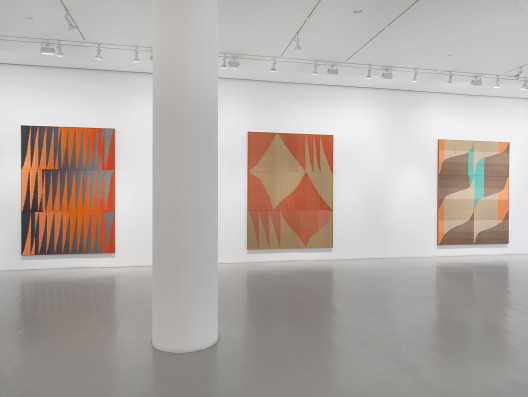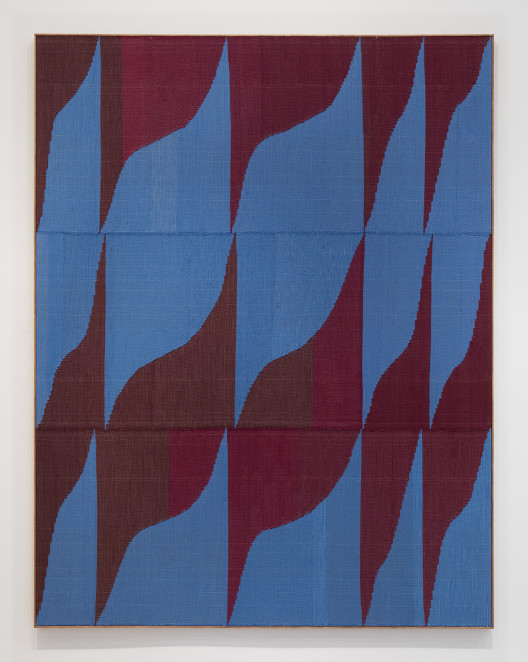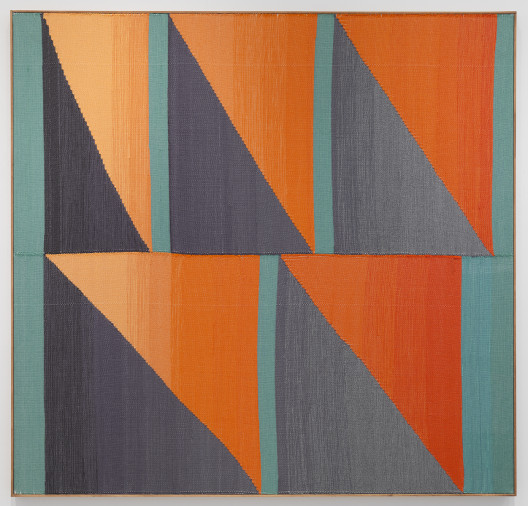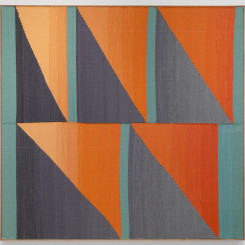Brent Wadden (b. 1979, Canada) has just completed his first major solo exhibition in New York at Mitchell-Innes and Nash. The show presented 8 large-scale woven works. Having trained as a painter, Wadden (working between studios in Vancouver and Berlin) is now focused on weaving, using brightly colored yarns to create dense, abstract pieces which are then taken down and stretched over canvas.
Iona Whittaker: We could begin with how you started weaving, and how it took over as the main medium in which you now work.
Brent Wadden: I started weaving in Berlin [Wadden began renting a studio there in 2004]. I wanted to work on a specific project. I reached out to Travis Meinhof and asked if he could show me. He lent me a little laser cut loom about 8 inches wide which provided me with a starting point.
At the beginning, I was still painting a lot and doing work on other projects; it’s only been in the last two or three years that I have solely been weaving. It’s very nimble; it’s very time-consuming. Painting is more about sitting there and thinking and making decisions; the weaving process is more about working all the time. It’s a time-based process.
IW: You said you were totally drawn into it—what do you think did that? Is it something about the method that you enjoyed?
BW: I really need to focus on it. It’s less meditative like traditional weaving. Yes, I still work for long periods of time and I do fall into that state of working. And I come from a working class family and work is in my blood. I think it was natural for me to be drawn to process-based art.
IW: When you have to switch a color, how do you make that decision? Or do you plot them put before you start?
BW: Compositionally, I do. I need to be strategic about them because in the early period when I was weaving I was working mostly in black and white or in two colors. I would make a lot of weavings—maybe I would make 50 panels, although almost all of these works [in the current exhibition] except for one are three panels. In the beginning, I would make say 30 or 40 weavings as individual panels and I would put them together later to make the compositions; so it was a case of which worked together. The composition was the last part of the process—the fun part! With these colored ones, you can’t see until they come off the loom how they will fit together, because you can only see about a foot ahead.
IW: In terms of the process, you are committed to it from the start—you cannot really imagine it until it is complete; mistakes, I suppose, can be undone, but it isn’t easy. How many do you reject?
BW: I hate doing that, actually. I have never not shown a piece, which is weird because most artists don’t do that. My production is very slow—I perhaps don’t know if a piece is good, I just know that I made this thing.
IW: The way it comes into view for you is very different from how it comes across to the public. The impact of these pieces for the viewer in the gallery is striking and immediate, whereas for you they have evolved over time.

Brent Wadden solo exhibition view at Mitchell-Innes and Nash, New York. Courtesy of the artist; Peres Projects, Berlin; and Mitchell-Innes & Nash, New York.
BW: Yes. And when you’ve finished it you need to clean it off. There are little strings having off it, lint and cat hair. Once you clean it up you think, “Wow it looks like art all of a sudden.” When people visit the studio I lay them out on the floor and they simply look like cloth, which has a different meaning for people.
IW: A transition happens when you stretch them and make them look very pristine—they then look more like paintings.
BW: Yes, I think the language of making the images comes from my background in painting, although I am interested in pattern-making.
IW: This is a big series—have you always been working on this scale?
BW: I think this is the third exhibition for which I have had works this size. They are almost exactly the same size, which is just the one I have my looms set at right now, and it feels really comfortable.
IW: When you see them in an exhibition like this, does it show you new things about them, or things you hadn’t noticed?
BW: Well, I always feel they go too quickly. I stretch and frame them, then they get picked up by the shipper. I haven’t had much opportunity to have them around very long. I have a few paintings I kept back in Vancouver and in Berlin when I go there. The first thing I do when I get back is unwrap all these old paintings in the studio and put them around. I also have some weavings there and I’ll spend some time with them. They are growing on me more and more each year. For this show, the works were very quickly stretched and framed, then I see them here for a few days [in the exhibition], then that might be it. But it’s good to feel unattached to the work. You are letting things go. I’ve kept the things that are really personal and will never sell them.

Brent Wadden, “Blue Wine”, hand woven fibers, wool, cotton and acrylic on canvas, 271.8 x 208.3 cm. Courtesy of the artist; Peres Projects, Berlin; and Mitchell-Innes & Nash, New York.
IW: How do the titles work?
BW: Most of them are pretty simple. They are based on the colors that are there; I was actually going to have all the works untitled and have the color reference in parentheses, but then I thought, f#%^k the brackets.
IW: Have you been surprised by reactions to them here?
BW: Not yet. I guess that’s what we are waiting to see. People usually don’t understand how it’s made. It’s very different, for example, from the digital painting which is so popular now. It’s easy to make a painting on a screen and print it out. These are at the other end of the spectrum, although people find visual similarities between these pieces and digitally produced works.
IW: Thinking about the reception of your work in different places, it seems it makes an interesting transition from craft or domestic use to a high art context in a gallery like this.

Brent Wadden, “5 Green Bars (double fade)”, hand woven fibers, wool, cotton and acrylic on canvas, 180.3 x 188 cm, 2015. Courtesy of the artist; Peres Projects, Berlin; and Mitchell-Innes & Nash, New York.
BW: I think it’s great; it can lower a barrier that people have towards contemporary art. A lot of people hate weaving and all the things it stands for. But it’s interesting to dispense with brushstrokes and those things that are always attached to painting and replace them with yarn.

